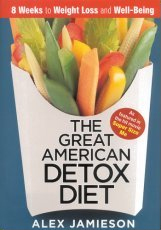 Excerpt
from The Great American Detox Diet: 8 Weeks to Weight Loss and Well-Being
Excerpt
from The Great American Detox Diet: 8 Weeks to Weight Loss and Well-Being
by Alex Jamieson
What's the Difference Between a Refined and An Unrefined Carbohydrate?
Do you remember making papier-mâché projects in arts and crafts class? The usual tools were strips of newspaper and a bowl of paste. That paste was made of a simple, cheap combination of ingredients: just standard white flour and water. It was sticky, it was gooey, and it worked like glue that hardened in no time. Now think about the last time you ate a piece of white bread or other refined-flour product. The flour in that white bread, once it was moistened with your saliva, became like that pasty glue, and this is what was sent into your digestive system: a gummy, nutrient-poor glob of starch. This is what your digestive system looked forward to processing. It's not tough to imagine how little nutrition was drawn from this ball of sticky matter, or how difficult it was for your body to finally eliminate it.
What's been "refined" out of these processed carbohydrates are all the beneficial nutrients that nature originally put into them. The bran, the fiber, and most of the vitamins and minerals have been stripped away, leaving a bland, white, longer-lasting and shelf-stable product. White flour has only 20 percent of the vitamins and minerals and 25 percent of the fiber of the original wheat kernel. That's why a lot of bread products are "enriched" with vitamins and minerals -- they don't contain enough to mention otherwise. Whole wheat flour still contains the hull, germ, and bran of the grain and offers more fiber and nutrients. I look forward to the day when fast-food restaurants offer whole grain buns and fiber-rich side dishes to their customers, instead of the empty carbs that they now push on us so aggressively.
Now that we've talked a little bit about carbohydrates, why don't you take a minute to ask yourself if you might be eating too many of the refined, highly processed variety.
One way to distinguish between carbohydrates that harm us and carbohydrates that heal us is to think about their fiber content. Products that are made out of refined white flour and white sugar usually have very little fiber and are very processed. Fiber-filled carbohydrates are better for you than those with little or no fiber. Fiber provides a barrier for your digestive system -- otherwise the carbohydrates get turned into sugar immediately. Most Americans eat around 12 grams of fiber a day, while the recommended daily intake ranges from 20 to 45 grams. Yet we are overconsuming carbohydrates! Whenever you reach for a box of cereal, a loaf of bread, or any other product made with flour (pastas, etc.), always reach for the brand that lists whole wheat or another whole grain as the first ingredient. And also check the fiber content and go with the one that has the most fiber per serving.
In the last several years, a more sophisticated method has emerged to help us understand which carbs are good and which are bad. This is what is known as the glycemic index, or GI. The glycemic index rates how many readily available sugar is in a particular food. This, in turn, indicates how quickly that food will affect your blood sugar level. White bread, potatoes, and refined cereals, which are rapidly digested, create a surge in blood sugar levels, and so these are classified with high GI ratings. Foods with low GI ratings, such as vegetables, whole grain products, and beans are metabolized more slowly, largely because of their fiber content. These low-GI foods don't cause drastic changes in blood sugar levels and thereby eliminate the highs and lows that can lead to excess snacking and sugar cravings. Making a simple switch in the foods you eat can have a profound effect on your health. For example, eating brown rice instead of white rice will do wonders for controlling your blood sugar level. So will switching from white bread to whole grain bread. Plus, the extra fiber in these foods will expand in your stomach, so you will feel full faster and longer after eating whole grain products. When you're buying whole grain products, continue to be a good food detective and watch out for any ingredients that you are trying to avoid.
Fiber supplements can also be helpful in eliminating the toxic wastes that build up in our bodies when we eat a diet of highly refined carbs. But supplements aren't magic bullets: The best way to ensure that your body is getting the kinds of carbs it needs to run smoothly and stay "clean" is to keep eating whole grains, beans, vegetables, and fruits that give you the extra dose of fiber needed to clean out your system. The natural foods with the highest amounts of fiber are lentils; black, kidney, and lima beans; chickpeas; potatoes with the skin; peas; non-instant oatmeal; pears and apples with the skin; Brussels sprouts; and peaches.
Copyright © 2005 Alexandra Jamieson
Reprinted from: The Great American Detox Diet: 8 Weeks to Weight Loss and Well-Being by Alex Jamieson. Copyright © Alexandra Jamieson; Permission granted by Rodale, Inc., Emmaus, PA 18098. Available wherever books are sold or directly from the publisher by calling (800) 848-4735 or visit their website at www.rodalestore.com
